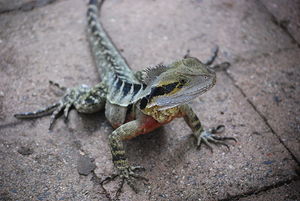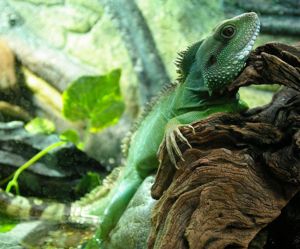Difference between revisions of "Water Dragon"
| (8 intermediate revisions by 4 users not shown) | |||
| Line 1: | Line 1: | ||
| − | {{ | + | {{review}} |
| − | + | [[Image:Physignathus_lesueurii.jpg|300px|thumb|right|'''Australian water dragon''' (© Andrew Napier, Wikimedia Commons)]] | |
| − | [[Image:Physignathus_lesueurii.jpg|300px|thumb|right|'''Australian water dragon''' (Wikimedia Commons)]] | + | ==Introduction== |
| − | |||
| − | |||
Scientific name: ''Physignathus'' spp. | Scientific name: ''Physignathus'' spp. | ||
| − | |||
*Chinese, Thai or green Water dragon - ''P. cocincinus'' | *Chinese, Thai or green Water dragon - ''P. cocincinus'' | ||
*Australian or Eastern Water dragon - ''P. lesueurii'' | *Australian or Eastern Water dragon - ''P. lesueurii'' | ||
| Line 14: | Line 11: | ||
===Thai or green Water dragon (''P. cocincinus'')=== | ===Thai or green Water dragon (''P. cocincinus'')=== | ||
| − | Adult males may reach 90-100cm in length. They are large bright green lizards with an obvious dorsal crest continuing as a row of enlarged dorsal scales running from the back of the head to the tail. This crest is more obvious in males. There are conical scales at the angle of the jaws and an exposed tympanum. The chin is white and the throat may be yellow or white. The eye is bright amber. Superficially they resemble some of the South American iguanids such as ''Iguana'' and ''Baciliscus'' spp. | + | Adult males may reach 90-100cm in length. They are large bright green lizards with an obvious dorsal crest continuing as a row of enlarged dorsal scales running from the back of the head to the tail. This [[Crest|crest]] is more obvious in males. There are conical scales at the angle of the jaws and an exposed tympanum. The chin is white and the throat may be yellow or white. The eye is bright amber. Superficially they resemble some of the South American iguanids such as ''Iguana'' and ''Baciliscus'' spp. |
===Australian or Eastern Water dragon (''P. lesueurii'')=== | ===Australian or Eastern Water dragon (''P. lesueurii'')=== | ||
Adults with rusty reddish sides, a dark temporal streak, and pronounced dark banding may reach 90cm. There is a low dorsal crest from head to tail. They are swift moving, alert lizards that resist most attempts at handling. They have a painful bite and sharp claws. | Adults with rusty reddish sides, a dark temporal streak, and pronounced dark banding may reach 90cm. There is a low dorsal crest from head to tail. They are swift moving, alert lizards that resist most attempts at handling. They have a painful bite and sharp claws. | ||
| − | |||
| − | |||
==Range== | ==Range== | ||
| Line 37: | Line 32: | ||
==Enclosure== | ==Enclosure== | ||
| + | [[Image:Chinese_water_dragon.jpg|300px|thumb|right|'''Chinese water dragon''' <br> Jakub Hałun 2009, Wikimedia Commons]] | ||
Water dragons require a large enclosure. Rostral abrasions are a common problem with this species. They need space; at least twice their total length - so a minimum of 1.8m long, by at least 90cm width and 1.2-1.8m high. They are semi-arboreal, need enough branches for climbing, ground for roosting and feeding and water to submerge and swim in. They also need sufficient heat and UVB light. Branches should also be provided and need to be at least as wide as the dragons; place them diagonal for climbing, horizontal for roosting. | Water dragons require a large enclosure. Rostral abrasions are a common problem with this species. They need space; at least twice their total length - so a minimum of 1.8m long, by at least 90cm width and 1.2-1.8m high. They are semi-arboreal, need enough branches for climbing, ground for roosting and feeding and water to submerge and swim in. They also need sufficient heat and UVB light. Branches should also be provided and need to be at least as wide as the dragons; place them diagonal for climbing, horizontal for roosting. | ||
| Line 53: | Line 49: | ||
Daytime: 24-30ºC, dropping to a minimum of 19ºC at night. They must have a basking area going up to 35ºC during day at one side of the tank. Use thermometers. | Daytime: 24-30ºC, dropping to a minimum of 19ºC at night. They must have a basking area going up to 35ºC during day at one side of the tank. Use thermometers. | ||
| + | |||
| + | ==Literature Search== | ||
| + | [[File:CABI logo.jpg|left|90px]] | ||
| + | |||
| + | |||
| + | Use these links to find recent scientific publications via CAB Abstracts (log in required unless accessing from a subscribing organisation). | ||
| + | <br><br><br> | ||
| + | [http://www.cabdirect.org/search.html?q=(od:(Water+Dragon)+OR+title:(Water+Dragon)+OR+ab:(Water+Dragon)+OR+od:(Physignathus)+OR+title:(Physignathus)+OR+ab:(Physignathus))&fq=sc:%22ve%22 Water Dragon (''Physignathus'' spp.) publications] | ||
| + | |||
| + | [http://www.cabi.org/cabdirect/FullTextPDF/2009/20093355665.pdf ''' A retrospective review of the diseases in family Agamidae (Agamas, bearded dragons, frilled dragon, water dragons).''' Reavill, D.; Schmidt, R.; Baer, C. K.; Association of Reptilian and Amphibian Veterinarians, Chester Heights, USA, Proceedings of the Association of Reptilian and Amphibian Veterinarians, 16th Annual Conference, Milwaukee, Wisconsin, USA, 8-15 August, 2009, 2009, pp 111-116, 7 ref. - '''Full Text Article'''] | ||
| + | |||
| + | |||
| + | [[Category:Lizard_Species]] | ||
| + | [[Category:Lizard_and_Snake_Glossary]] | ||
Latest revision as of 23:20, 7 November 2010
| This article has been peer reviewed but is awaiting expert review. If you would like to help with this, please see more information about expert reviewing. |
Introduction
Scientific name: Physignathus spp.
- Chinese, Thai or green Water dragon - P. cocincinus
- Australian or Eastern Water dragon - P. lesueurii
- Southeast Asian Water dragon - P. temporalis
Descriptions
Thai or green Water dragon (P. cocincinus)
Adult males may reach 90-100cm in length. They are large bright green lizards with an obvious dorsal crest continuing as a row of enlarged dorsal scales running from the back of the head to the tail. This crest is more obvious in males. There are conical scales at the angle of the jaws and an exposed tympanum. The chin is white and the throat may be yellow or white. The eye is bright amber. Superficially they resemble some of the South American iguanids such as Iguana and Baciliscus spp.
Australian or Eastern Water dragon (P. lesueurii)
Adults with rusty reddish sides, a dark temporal streak, and pronounced dark banding may reach 90cm. There is a low dorsal crest from head to tail. They are swift moving, alert lizards that resist most attempts at handling. They have a painful bite and sharp claws.
Range
Water dragons are native to the Southeast Asian mainland and archipelago.
Diet
Unlike iguanas they are largely carnivorous but will eat some vegetable items.
- Feeding hatchlings and juveniles - Offer 2-3 week old nutrient-loaded crickets. Also offer finely chopped vegetables and fruits (bananas, pears, strawberries etc.) As the dragons grow, offer only slightly bigger crickets, and add in some mealworms and pinkie mice, and occasionally a waxworm. Smaller food items are more nutritious and more efficiently digested than fewer bigger items. Feed every two days or more often if they appear hungry.
- Adults - Offer small mice, 4 week old crickets and kingworms as well as plant matter. Feed every two to three days, or more often if they look hungry. Also feed plant matter, such as greens and fruits (see iguana salad for recipe).
The diet should obviously be supplemented.
Enclosure
Water dragons require a large enclosure. Rostral abrasions are a common problem with this species. They need space; at least twice their total length - so a minimum of 1.8m long, by at least 90cm width and 1.2-1.8m high. They are semi-arboreal, need enough branches for climbing, ground for roosting and feeding and water to submerge and swim in. They also need sufficient heat and UVB light. Branches should also be provided and need to be at least as wide as the dragons; place them diagonal for climbing, horizontal for roosting.
- Substrate: the ideal substrate is a mixture of two-thirds peat soil and one-third clean sand with areas of bark. Water dragons can also be kept on fake Astroturf or newspaper. They have very active digestive systems and so cages need regular cleaning.
- Plants: Dracaena, pothos, figs, philodendron and staghorn ferns are suitable. They will need to be replaced as they are shredded by claws or eaten.
- UVB lighting: Must have direct sun (preferable) or a suitable UVB-producing fluorescent.
- Heating: Use overhead heating and basking lights; an infrared basking lamp is strongly recommended. Under-tank heating pads are adequate if used properly. Avoid using hot rocks with this species, as the lizards tend to overheat on these appliances.
- Water: This must be available at all times for full body immersions (or at least up to half their height). It must be cleaned daily and disinfected regularly (preferably every day).
Temperature
Daytime: 24-30ºC, dropping to a minimum of 19ºC at night. They must have a basking area going up to 35ºC during day at one side of the tank. Use thermometers.
Literature Search
Use these links to find recent scientific publications via CAB Abstracts (log in required unless accessing from a subscribing organisation).
Water Dragon (Physignathus spp.) publications


